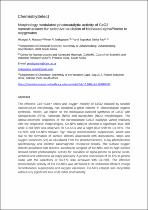 ResearchSpace
ResearchSpace
Morphology modulated photocatalytic activity of CeO2 nanostructures for selective oxidation of biobased alphaPinene to oxygenates
JavaScript is disabled for your browser. Some features of this site may not work without it.
- ResearchSpace
- →
- Research Publications/Outputs
- →
- Journal Articles
- →
- View Item
| dc.contributor.author |
Mavuso, MA

|
|
| dc.contributor.author |
Makgwane, Peter R

|
|
| dc.contributor.author |
Ray, Suprakash S

|
|
| dc.date.accessioned | 2021-04-06T08:29:04Z | |
| dc.date.available | 2021-04-06T08:29:04Z | |
| dc.date.issued | 2020-11 | |
| dc.identifier.citation | Mavuso, M., Makgwane, P.R. & Ray, S.S. 2020. Morphology modulated photocatalytic activity of CeO2 nanostructures for selective oxidation of biobased alphaPinene to oxygenates. <i>ChemistrySelect, 5(42).</i> http://hdl.handle.net/10204/11941 | en_ZA |
| dc.identifier.issn | 2365-6549 | |
| dc.identifier.uri | https://doi.org/10.1002/slct.202002285 | |
| dc.identifier.uri | https://chemistry-europe.onlinelibrary.wiley.com/doi/full/10.1002/slct.202002285 | |
| dc.identifier.uri | http://hdl.handle.net/10204/11941 | |
| dc.description.abstract | The effective Ce3+/Ce4+ redox and oxygen mobility of CeO2 induced by tunable nanostructure morphology has attracted a great interest in photocatalytic organic synthesis. Herein, we report on the microwave‐assisted synthesis of CeO2 with nanoparticles (NPs), nanorods (NRs) and nanocubes (NCs) morphologies. The optical‐electronic properties of the nanostructure CeO2 catalysts varied relatively with the respective morphologies. Ce‐NPs catalyst showed a significant blue shift while a red shift was observed for Ce‐NCs and a slight blue shift for Ce‐NRs. The Ce‐NRs and Ce‐NPs showed high charge recombination suppression, which was due to the formation of surface defects associated with dislocations, steps and oxygen vacancies (Vo) as elucidated from the photolumiscence, X‐ray photoelectron spectroscopy and electron paramagnetic resonance results. The surface oxygen defects populated with reactive superoxide oxygens of Ce‐NRs and its high surface showed better photocatalytic activity for oxidation of alpha‐pinene to pinene oxide, verbenol and verbenone as major products. A pinene conversion of 33.6 % to pinene oxide with the selectivity of 54.3 % was achieved with Ce‐NRs. The effective photocatalytic activity of the Ce‐NRs was attributed to its enhanced efficient charge recombination suppression and oxygen vacancies. Ce‐NRs catalyst was recyclable without any significant loss of its initial photoactivity. | en_US |
| dc.format | Abstract | en_US |
| dc.language.iso | en | en_US |
| dc.source | ChemistrySelect, 5(42) | en_US |
| dc.subject | Ce3+/Ce4+ redox | en_US |
| dc.subject | Nanoparticles | en_US |
| dc.subject | Nanorods | en_US |
| dc.subject | Nanocubes | en_US |
| dc.title | Morphology modulated photocatalytic activity of CeO2 nanostructures for selective oxidation of biobased alphaPinene to oxygenates | en_US |
| dc.type | Article | en_US |
| dc.description.pages | 12940-12951 | en_US |
| dc.description.note | © 2020 Wiley‐VCH GmbH. Due to copyright restrictions, the attached PDF file contains the abstract of the full-text item. For access to the full-text item, please consult the publisher's website: https://doi.org/10.1002/slct.202002285 | en_US |
| dc.description.cluster | Chemicals | en_US |
| dc.description.impactarea | Advanced Functional Materials | en_US |
| dc.description.impactarea | CeNAM | |
| dc.identifier.apacitation | Mavuso, M., Makgwane, P. R., & Ray, S. S. (2020). Morphology modulated photocatalytic activity of CeO2 nanostructures for selective oxidation of biobased alphaPinene to oxygenates. <i>ChemistrySelect, 5(42)</i>, http://hdl.handle.net/10204/11941 | en_ZA |
| dc.identifier.chicagocitation | Mavuso, MA, Peter R Makgwane, and Suprakash S Ray "Morphology modulated photocatalytic activity of CeO2 nanostructures for selective oxidation of biobased alphaPinene to oxygenates." <i>ChemistrySelect, 5(42)</i> (2020) http://hdl.handle.net/10204/11941 | en_ZA |
| dc.identifier.vancouvercitation | Mavuso M, Makgwane PR, Ray SS. Morphology modulated photocatalytic activity of CeO2 nanostructures for selective oxidation of biobased alphaPinene to oxygenates. ChemistrySelect, 5(42). 2020; http://hdl.handle.net/10204/11941. | en_ZA |
| dc.identifier.ris | TY - Article AU - Mavuso, MA AU - Makgwane, Peter R AU - Ray, Suprakash S AB - The effective Ce3+/Ce4+ redox and oxygen mobility of CeO2 induced by tunable nanostructure morphology has attracted a great interest in photocatalytic organic synthesis. Herein, we report on the microwave‐assisted synthesis of CeO2 with nanoparticles (NPs), nanorods (NRs) and nanocubes (NCs) morphologies. The optical‐electronic properties of the nanostructure CeO2 catalysts varied relatively with the respective morphologies. Ce‐NPs catalyst showed a significant blue shift while a red shift was observed for Ce‐NCs and a slight blue shift for Ce‐NRs. The Ce‐NRs and Ce‐NPs showed high charge recombination suppression, which was due to the formation of surface defects associated with dislocations, steps and oxygen vacancies (Vo) as elucidated from the photolumiscence, X‐ray photoelectron spectroscopy and electron paramagnetic resonance results. The surface oxygen defects populated with reactive superoxide oxygens of Ce‐NRs and its high surface showed better photocatalytic activity for oxidation of alpha‐pinene to pinene oxide, verbenol and verbenone as major products. A pinene conversion of 33.6 % to pinene oxide with the selectivity of 54.3 % was achieved with Ce‐NRs. The effective photocatalytic activity of the Ce‐NRs was attributed to its enhanced efficient charge recombination suppression and oxygen vacancies. Ce‐NRs catalyst was recyclable without any significant loss of its initial photoactivity. DA - 2020-11 DB - ResearchSpace DP - CSIR J1 - ChemistrySelect, 5(42) KW - Ce3+/Ce4+ redox KW - Nanoparticles KW - Nanorods KW - Nanocubes LK - https://researchspace.csir.co.za PY - 2020 SM - 2365-6549 T1 - Morphology modulated photocatalytic activity of CeO2 nanostructures for selective oxidation of biobased alphaPinene to oxygenates TI - Morphology modulated photocatalytic activity of CeO2 nanostructures for selective oxidation of biobased alphaPinene to oxygenates UR - http://hdl.handle.net/10204/11941 ER - | en_ZA |
| dc.identifier.worklist | 24101 | en_US |





